Przesłanki historyczne ujednolicania prawa własności w Unii Europejskiej
Historical Premises of Unification of Owner’s Rights in the EU
Author(s): Bartłomiej WoźniakSubject(s): Law, Constitution, Jurisprudence
Published by: Wydawnictwa Uniwersytetu Warszawskiego
Keywords: prawo; nauki prawne; teoria i praktyka prawa; law; legal science; theory and pratcical law
Summary/Abstract: Ownership is a central institution of private law and the core of property law. It is usually treated as strictly national area which has been hardly influenced by the process of harmonization. However, the Europeanization of other areas of private law requires creation of common proprietary rights, including ownership. Crucial differences in the concept of ownership exist between civil law, based on the Roman legal tradition, and common law with its medieval roots. Roman ownership was the most comprehensive right from which simple rights (to use, to dispose, to possess) descend. In contrast to common law, classical Roman law refused temporary ownership or split title. These functions were fulfilled by well-developed limited proprietary rights, strictly separated from ownership. Ownership was usually omitted in the process of harmonization of European private laws. One of the few examples of projects to unify ownership to some extent was presented in the Draft Common Frame of Reference – a private study on European civil code. The DCFR did not answer directly the question which concept of ownership should be adopted in the common European law of the future. Numerous references to Roman law indicate, however, that the authors of the DCFR included Roman legal tradition in their studies and, as regards the ownership right, they preferred continental solutions to the approach of the English common law.
Journal: Studia Iuridica
- Issue Year: 2014
- Issue No: 59
- Page Range: 285-325
- Page Count: 41
- Language: Polish

